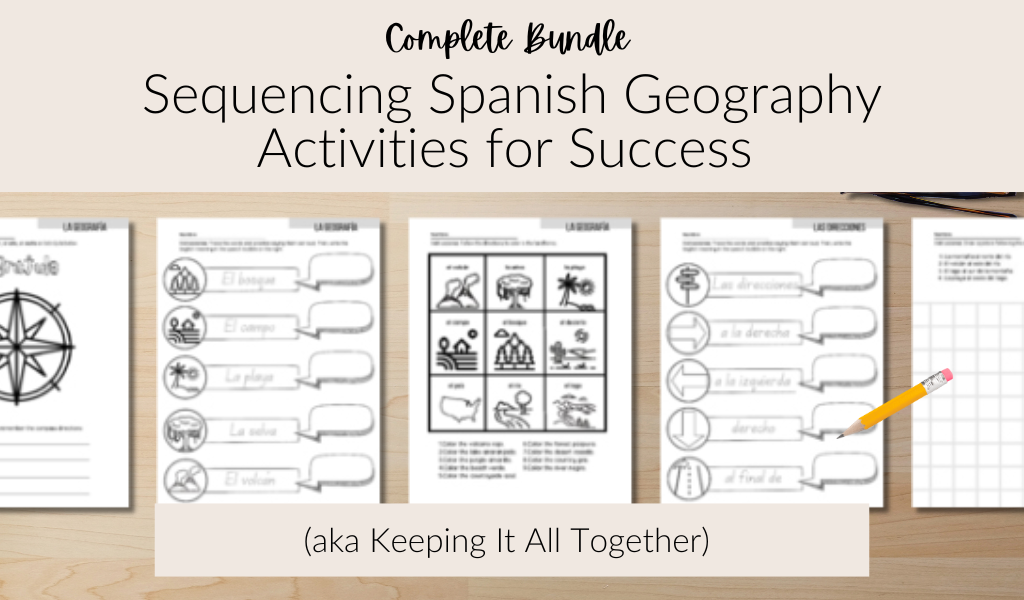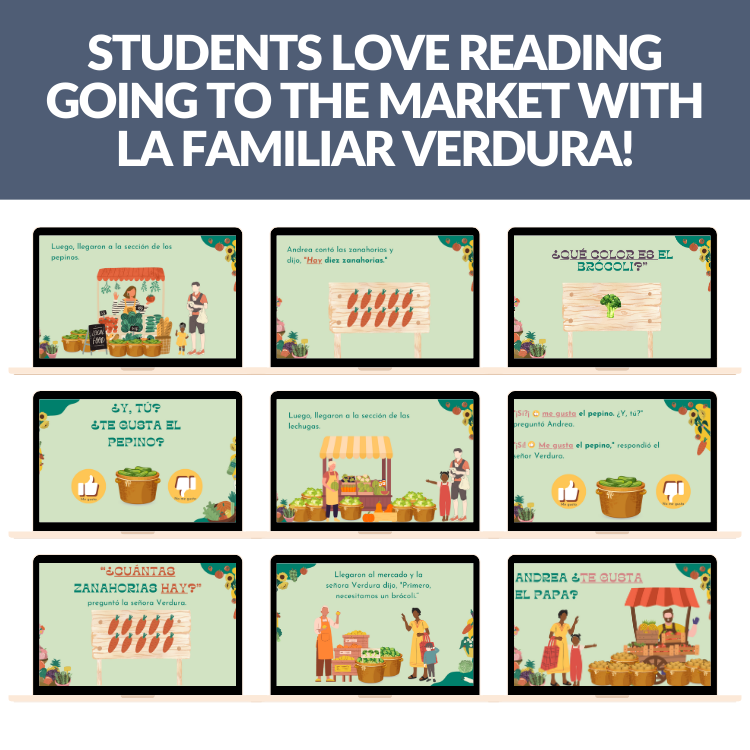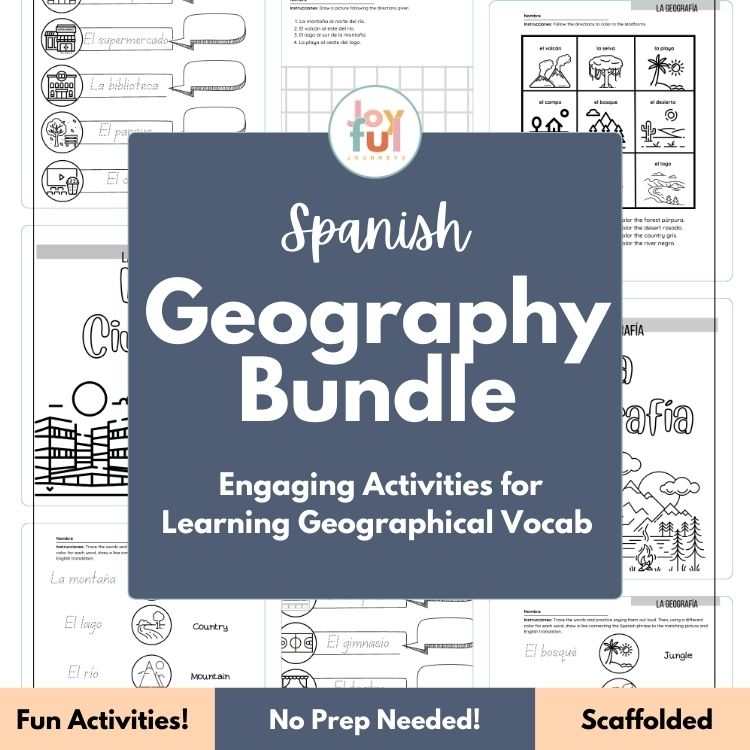Learning geography in Spanish doesn’t have to feel like watching paint dry! With the Spanish Geography Bundle, your students will dive into geographical vocabulary through exciting lessons, whole-class games, and hands-on crafts. Today, we’ll talk about how to sequence these activities for maximum fun (and learning!), incorporate whole class, partner, and independent work, and I’ll throw in some creative craft and game ideas to make geography come alive in your classroom. Let’s get those kids moving, crafting, and most importantly, speaking Spanish!
Spanish Geography Bundle: Vocabulary, Directions, Partner and Independent Activities
Here’s how you can smoothly sequence these activities so you don’t feel like you’re juggling 20 tasks at once. It’s all about building up your students’ knowledge step-by-step and keeping them engaged. Trust me, they’ll never look at “la brújula” the same way again!
- Start with Whole-Class Instruction (You’re in Control!): Kick things off with the La Brújula and Las Direcciones activities. This is where you shine, introducing your students to cardinal directions and key geography terms like “el norte” and “el este.” It’s a great chance to show off your map skills and model how to complete the task—plus, it’s always fun pretending you’re an explorer!
- Move to Partner Activities (Teamwork Makes the Dream Work): Once your students have the basics down, let them work in pairs with the Puntos Cardinales Partner Activity. One student gives directions, the other draws what they hear. Spoiler alert: expect some hilarious drawings! This activity is all about communication and collaboration—two life skills wrapped up in one fun geography lesson.
- Independent Reinforcement (Give Yourself a Breather!): Now it’s time for your students to fly solo with the Spanish Directions Writing Activity and the Geography Coloring Activity. They’ll practice writing and coloring, solidifying the vocabulary you’ve worked so hard to teach them. And hey, it’s independent work—you’ve earned yourself a moment to sip that cold coffee on your desk!
Incorporating Whole-Class, Partner, and Independent Activities
Whole Class:
- Interactive Map Work (Let’s Get Lost… on Purpose): Use the La Brújula activity and a giant classroom map to introduce cardinal directions. Ask questions like, “¿Dónde está el volcán?” and let your students get hands-on with geography. (Warning: they may take this opportunity to point out places they want to visit—prepare for some enthusiastic dreaming!)
Partner Work:
- Draw It Out! (And Prepare to Laugh): With the Puntos Cardinales partner activity(PuntosCardinalesSpanish…), students describe landforms and directions while their partner draws the masterpiece. The end results might not be ready for the Louvre, but you’ll definitely get some great conversations and a few laughs out of it.
Independent Work:
- Solo Geography Time (Finally, Some Quiet!): Let students work on the Spanish Directions Writing Activity and Geography Coloring Activity. They’ll trace, write, and color their way to mastering geographical vocabulary—all while giving you a chance to quietly pat yourself on the back for a lesson well done.
3 Fun Crafts to Complement the Bundle (Get Crafty!)
- DIY Compass Craft (Look, I Made a Compass!):
Have students make their own cardboard compasses labeled with “norte,” “sur,” “este,” and “oeste.” Once complete, they can use their new DIY compass during class activities to practice giving directions. It’s both practical and an instant conversation starter when they get home and show it off! - Geography Diorama (Because Who Doesn’t Love a Diorama?):
Using vocabulary from the Geography Coloring Activity, students can create a diorama of a geographical scene. They can label features like “el río” and “la montaña.” It’s geography, creativity, and hands-on learning all wrapped up in one colorful project. - Pop-Up Landforms Book (3D Learning, Baby!):
Have your students create pop-up books featuring landforms like “el bosque” and “el volcán.” Each page could represent a different scene with sentences like “La playa está al este de la selva.” Bonus: You’ll get some amazing pop-up art for your classroom display!
3 Fun Classroom Games (Time to Burn Some Energy!)
- Mapa Humano (Human Map)—Get Moving:
Tape out a giant compass rose on the floor and call out directions like “¡Ve al sur!” Students have to dash to the right spot. The first one there? They get to call out the next direction. It’s like Simon Says but with a geography twist. Also, it’s a great way to get those wiggles out! - Race to the Landform (Friendly Competition!):
Divide the class into teams and call out a landform like “la montaña” or “el lago” from the Geography Coloring Activity. The first team to point to the correct place on the map wins bragging rights (or stickers—stickers are basically currency, right?).
Simon Dice, Versión Geografía (Simon Says, Geography Style):
A classic game with a twist! Use directional commands like “Simón dice, ve al este” or “gira a la derecha.” It’s all about reinforcing vocabulary while keeping the class on their toes (literally).
Why Engaging Students with Crafts and Games Matters
It’s not just about keeping them entertained (though, let’s be honest, that’s part of the battle). When students are physically engaged—whether through movement, crafting, or games—they’re more likely to remember the vocabulary they’re learning. Research shows that students who actively participate in lessons retain 30% more information than those in passive learning environments. And in a language classroom, active participation means speaking and using the language, which is key to long-term retention.
The Gist of it All
The Spanish Geography Bundle transforms a standard geography lesson into an exciting and interactive adventure! By combining whole-class instruction, partner activities, independent work, and a few fun crafts and games, your students will become geographical vocabulary pros in no time. With these activities, you’re not just teaching Spanish—you’re building a classroom full of explorers ready to take on the world!

Resources
Busciglio, D. (2023, July 14). Why real conversation is key to language learning. Why Real Conversation Is Key to Language Learning. https://www.lessonface.com/content/why-real-conversation-key-language-learning
McCAUGHEY, K., & ROSENBERG, R. (2024). Let Them Play: Board Games for Language Practice. U.S. Department of State. https://americanenglish.state.gov/forum



